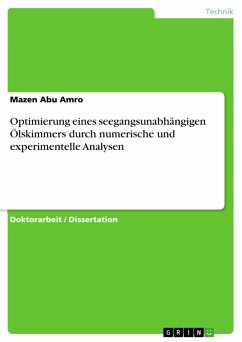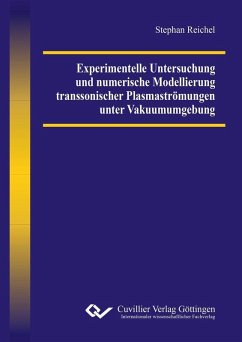
Optimierung eines seegangsunabhängigen Ölskimmers durch numerische und experimentelle Analysen (eBook, PDF)
Versandkostenfrei!
Sofort per Download lieferbar
Statt: 49,99 €**
39,99 €
inkl. MwSt. und vom Verlag festgesetzt.
**Preis der gedruckten Ausgabe (Broschiertes Buch)
Alle Infos zum eBook verschenkenWeitere Ausgaben:

PAYBACK Punkte
0 °P sammeln!
Doktorarbeit / Dissertation aus dem Jahr 2007 im Fachbereich Ingenieurwissenschaften - Maschinenbau, Note: mit Auszeichnung bestanden, Technische Universität Berlin (Institut für Land- und Seeverkehr), Sprache: Deutsch, Abstract: This Ph.D. thesis presents the optimization of the (mostly) sea state independent oil skimming system SOS by means of numerical and experimental analyses. Here the SOS performance of counteracting oil disasters at open sea is closely examined. As a result of the evaluation of the functional principle of the system, it is found that the SOS shows a higher e¿ciency c...
Doktorarbeit / Dissertation aus dem Jahr 2007 im Fachbereich Ingenieurwissenschaften - Maschinenbau, Note: mit Auszeichnung bestanden, Technische Universität Berlin (Institut für Land- und Seeverkehr), Sprache: Deutsch, Abstract: This Ph.D. thesis presents the optimization of the (mostly) sea state independent oil skimming system SOS by means of numerical and experimental analyses. Here the SOS performance of counteracting oil disasters at open sea is closely examined. As a result of the evaluation of the functional principle of the system, it is found that the SOS shows a higher e¿ciency compared to existing oil recovery systems - especially in high seas. The SOS does not feature any moving parts. The system consists of a moon pool (oil dike) and a pontoon (bow segment), which glides on the heavily moving, oil polluted water surface, damping the waves. As a result of this arrangement, the oil layer to ¿ows underneath the pontoon towards a transverse blade, which separates the oil from the water and protects the moon pool from wave e¿ects. At the trailing edge of the bow segment a vortex develops, accelerating the oil particles in addition to their positive buoyancy towards the water surface of the moon pool. The wave-induced motions of the system cause sloshing e¿ects of the ¿uid within the oil dike. These sloshing motions convey the oil particles over an adjustable slope into an oil sump from where they can be pumped ö in a concentrated form.
Dieser Download kann aus rechtlichen Gründen nur mit Rechnungsadresse in A, B, BG, CY, CZ, D, DK, EW, E, FIN, F, GR, HR, H, IRL, I, LT, L, LR, M, NL, PL, P, R, S, SLO, SK ausgeliefert werden.













